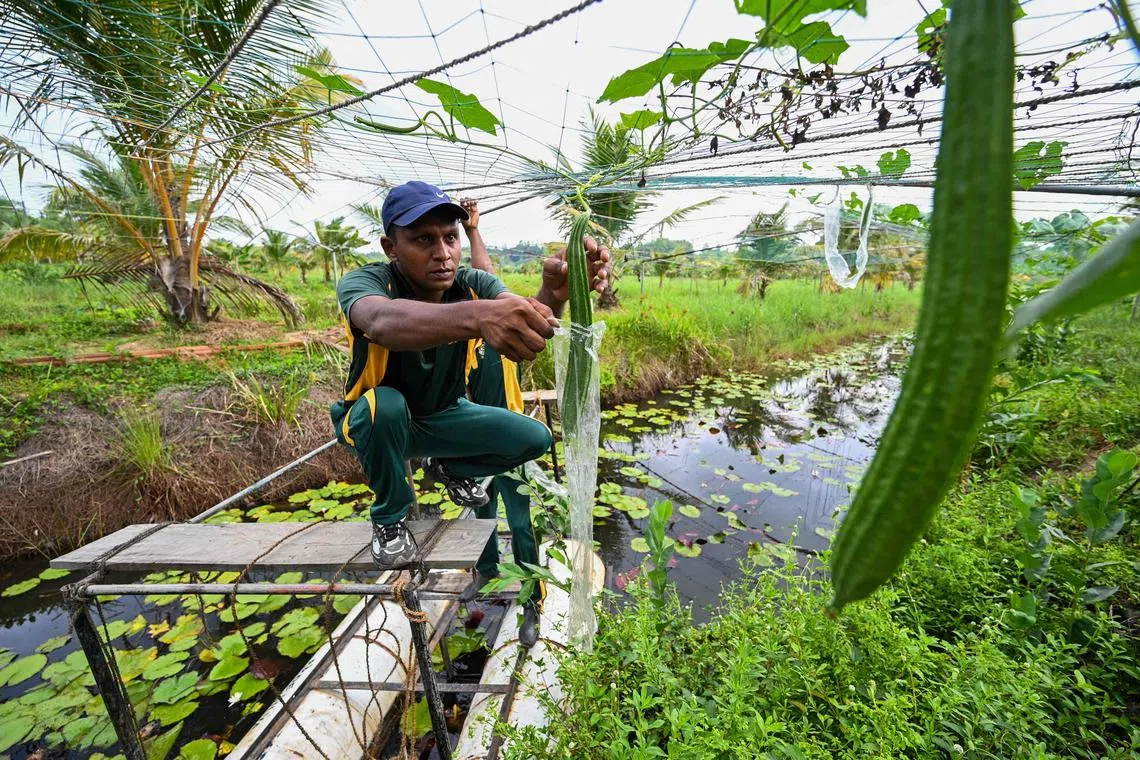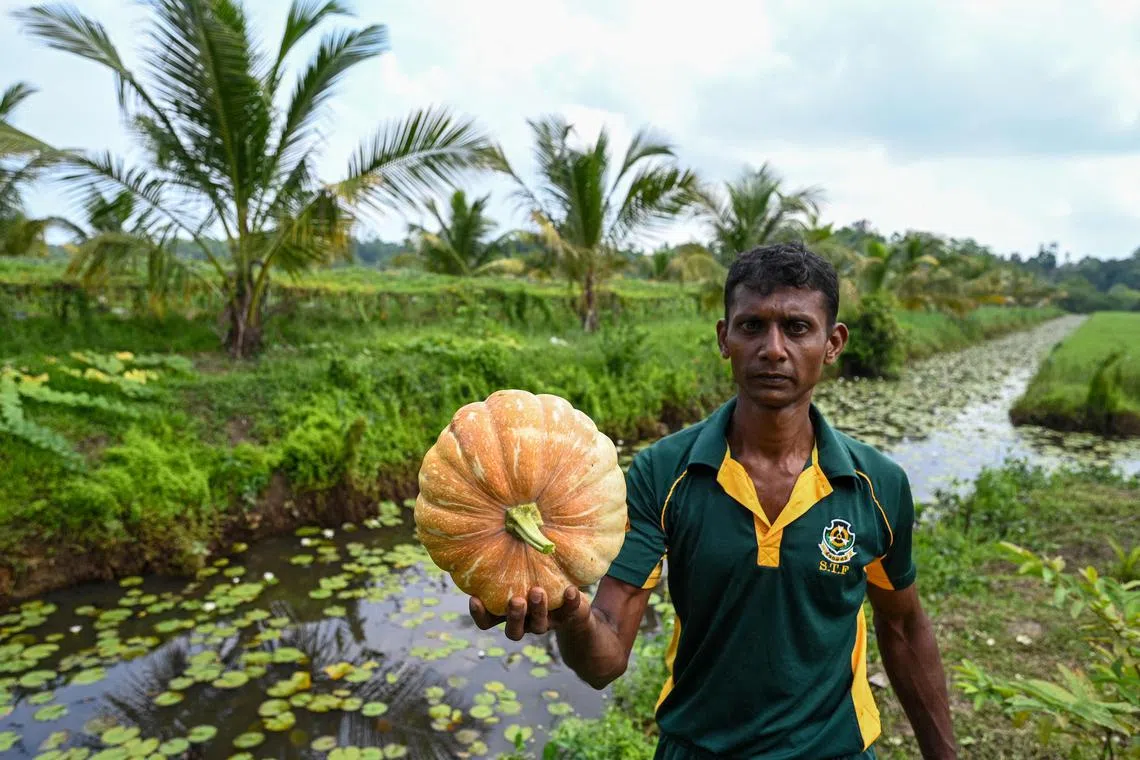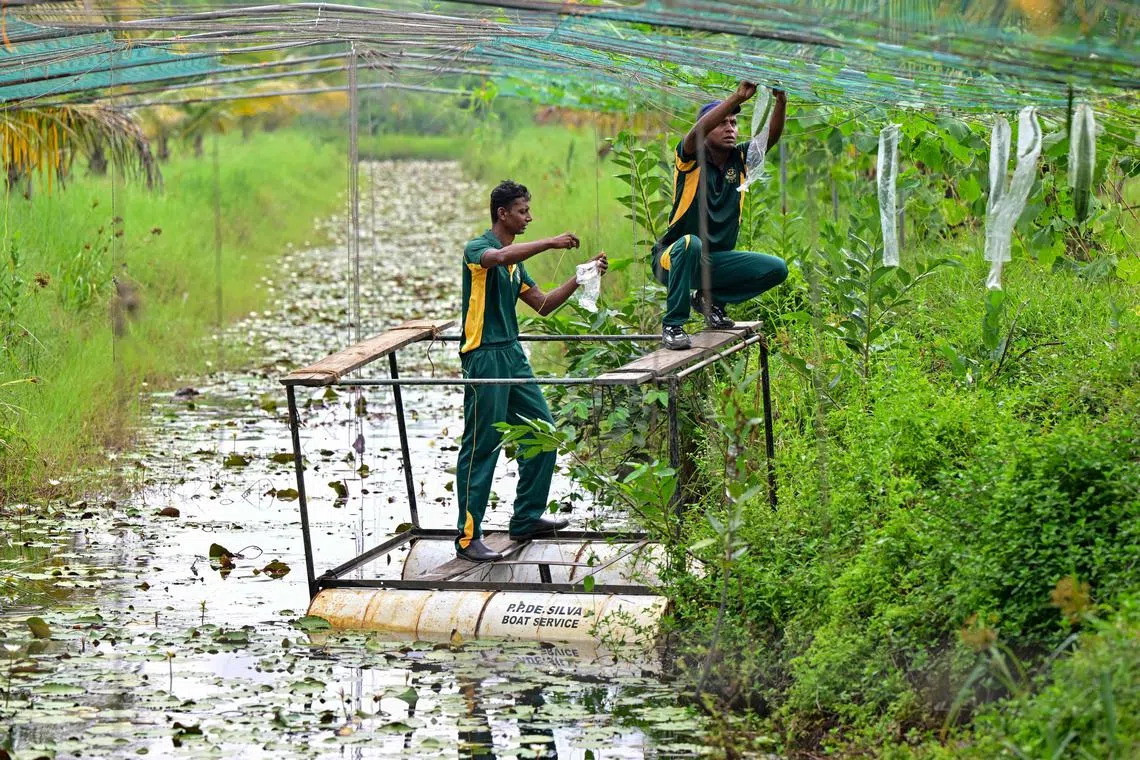Salt of the earth: Pilot project helping reclaim Sri Lankan farms
Sign up now: Get ST's newsletters delivered to your inbox

A Sri Lankan soldier works at a plantation in their model farm at Katukurunda.
PHOTO: AFP
Follow topic:
KATUKURUNDA, Sri Lanka – A commando in an elite Sri Lankan police unit, Mr Sameera Dilshan has an unusual mission: to reclaim farms poisoned by salt, a longstanding problem now accelerating due to climate change.
Increasing salinity is slowly and steadily swallowing traditional rice paddies along the island’s coastline, taking away the livelihood of generations of farmers.
Two hours’ drive south of the capital Colombo lies Katukurunda, one of the camps of the formidable Special Task Force (STF), an elite force created four decades ago to fight Tamil Tiger rebels.
While his colleagues train for riot control under the humid heat of the nearby Indian Ocean, the 35-year-old non-commissioned officer and his “commando-farmer” team are hoeing, weeding and watering.
Their goal? To grow coconut palms and a wide variety of fruit and vegetables in a paddy declared dead 40 years ago due to salt water contamination.
“This plantation was launched in 2022 as part of a government initiative to improve food security,” Mr Dilshan said.
The local authorities allocate land parcels for this purpose.
The method, known as “sorjan”, is similar to techniques used in Thailand and Indonesia. It reshapes flood-prone land by digging ponds where rice can be grown or fish raised, with more saline-tolerant coconut trees planted.
Embankments around these ponds are used for more delicate crops.
“We’re tending to 360 coconut trees planted here… along with pumpkins, gourds and cucumbers,” said Mr Dilshan. “In 2½ years, we’ll know if it’s a success or not.”
“It’s an efficient and climate-resilient production system that optimises land use and productivity, and increases farmers’ profits,” said Professor Buddhi Marambe, from the University of Peradeniya.
The UN Food and Agriculture Organisation (FAO) said in a 2024 report that saltwater from seas and oceans affects 10.7 per cent of the earth’s land, making it uncultivable in some cases.
It travels up rivers with the tides, seeps into soil through evaporation, and contaminates groundwater used for irrigation.
Climate change – which dries out the soil, reduces water resources or raises sea levels – is expected to increase the proportion of such “salty” land from 24 per cent to 32 per cent of the world’s surface area by the end of the century, the FAO warns.
These trends “threaten agricultural productivity and reduce crop yields in affected zones”, it warns.
Sri Lanka is no exception.
Prof Marambe estimates that 223,000ha, half of which are rice paddies, are impacted by salinity – nearly 8 per cent of the country’s total arable land.

A soldier holds a pumpkin at a plantation at a model farm at Katukurunda.
PHOTO: AFP
South of the pilot plantation lies the village of Parappuwa. It is surrounded by abandoned land.
Here, just a few kilometres from the sea, only a tiny portion of the paddy fields is still in use.
“Everything is polluted by salt that comes up during high tide,” said Mr Gamini Piyal Wijesinghe, 46, a farmer’s son who went into the restaurant business after leaving the army.
He pointed to a small stream, where 18 small dams had been built to stop the seawater.
“They weren’t constructed properly,” he said. “The water seeps through.”
Other former rice farmers have turned to cinnamon or rubber cultivation.
“Cinnamon is doing fairly well, but our income has significantly dropped since we stopped growing rice,” said Mr W.D. Jayaratne, 50, head of the local farmers’ association.
The future is gloomy.
“Salinity in the water is increasing and threatening our farmland,” he added. “There are also insects. Everywhere you look, there are problems.”
In this district of Kalutara, the local authorities are offering farmers abandoned land, seeking to bring them back under cultivation, mostly with coconut trees.
“We’ve already allocated 400ha and plan to increase that to 1,000ha in the next two years,” said the district chief, Mr Janaka Gunawardana.
“There’s high demand for coconut. It will create income for our people.”

Soldiers grow coconut palms and a wide variety of fruits and vegetables in a paddy declared dead 40 years ago due to salt water contamination.
PHOTO: AFP
Resistant varieties
In Katukurunda, Mr Aruna Priyankara Perera, 55, was encouraged by the success of the STF farming experiment.
“I got five acres (2ha) next to my hotel to replicate the STF’s project,” he said, standing in front of his freshly planted coconut and pumpkin field. “The land is free for two years, provided you can show it’s being cultivated.”
The local staple rice is a top concern for the authorities.
Prof Marambe said: “Soil salinity is a major issue in Sri Lanka.
“We’ve successfully tested several promising rice varieties that are resistant to salinity and flooding.”
The stakes are high.
A recent study of the Bentota river estuary, in the island’s south-west, found that half of local rice farmers had lost all their income due to saltwater contamination.
Even more seriously, Sri Lanka’s food security is now under threat. The last rice harvest, from September to March, was the country’s lowest since 2019.
“If we don’t all roll up our sleeves to bring salt-polluted land back into cultivation and production,” warned Prof Marambe, “the future will only get darker.” AFP

